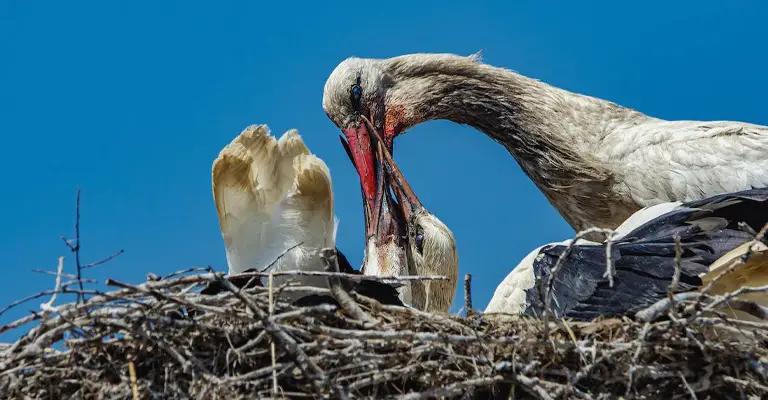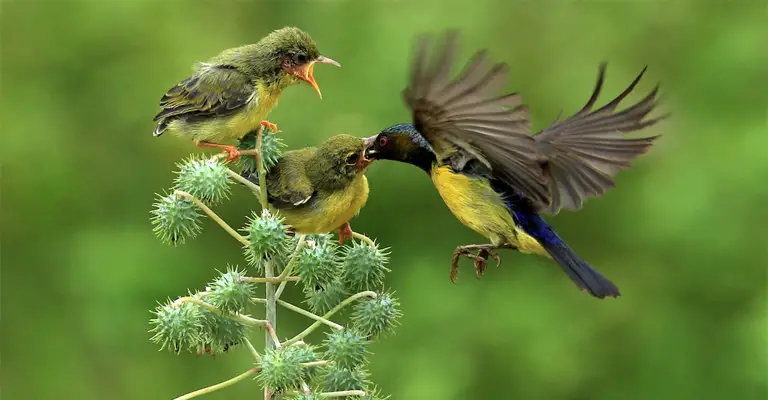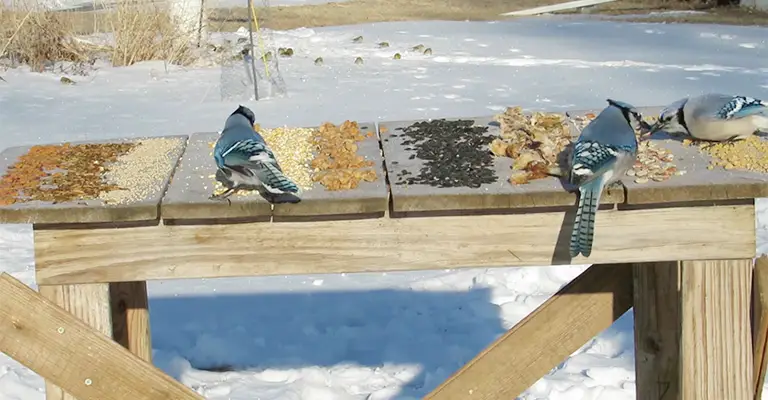In the vast symphony of nature, where every note plays a role in the intricate balance of ecosystems, the act of birds feeding each other emerges as a poignant and fascinating melody.
This behavior, known as “all feeding” or “allogrooming,” serves as a powerful testament to the complexities of avian relationships and the deep connections that underlie their interactions.
From courtship rituals to parental care and even among non-related individuals, the act of one bird feeding another transcends mere sustenance, embodying themes of bonding, communication, and cooperation.
Understanding why do birds feed each other invites us into the realm of avian social dynamics, reminding us that even in the avian world, the language of nourishment speaks volumes about the intricate tapestry of life.

Why Do Birds Feed Each Other
Birds feeding each other is a heartwarming display of affection and trust between two birds. This behavior is often seen in pairs or family groups, and it can be a sign of both courtship and bonding.
The birds demonstrate their commitment to one another by sharing food, which is an important part of their relationship.
Here are some possible reasons why birds feed each other, along with a brief description of each one.
Courtship
One of the most common reasons why birds feed each other is to attract a mate and to show their ability to provide for a potential partner or future offspring. This is especially common in spring when birds pair up to build their nests and lay eggs.
A male may approach an interested female carrying an insect, worm, or even a tasty nugget from a nearby bird feeder. If the female accepts the food, it is a sign of acceptance and interest.
Bonding
Another reason why birds feed each other is to strengthen their bond and to maintain their pair bond throughout the year.
This is especially important for monogamous birds, who stay with the same partner for life or for several breeding seasons.
By feeding each other, the birds are reaffirming their loyalty and affection for each other.
Cooperation
A third reason why birds feed each other is to cooperate and help each other in raising their young. This is common in cooperative breeders, who share the duties of nest building, incubation, and feeding among several individuals.
By feeding each other, the birds are ensuring that all the members of the group are well-fed and healthy, which benefits the survival of the offspring.
Altruism

A fourth reason why birds feed each other is to altruistically help another bird in need, even if it is not related or beneficial to them. This is rare in nature, but it has been observed in some cases.
For example, some birds have been seen feeding orphaned or abandoned young of their own or another species or feeding injured or sick adults who cannot feed themselves.
Reciprocity:
A fifth reason why birds feed each other is to reciprocate a favor or a service that another bird has done for them. This is based on the principle of “you scratch my back, I’ll scratch yours.”
For example, some birds may feed each other in exchange for grooming, protection, or information.
Learning
A sixth reason why birds feed each other is to learn from each other and to acquire new skills or knowledge. This is common in social learners, who imitate the behavior of others to improve their own performance.
By feeding each other, the birds are exposing themselves to new types of food or new ways of finding food.
Communication
A seventh reason why birds feed each other is to communicate with each other and to convey information or emotions. This is common in vocal learners, who use sounds to express themselves and interact with others.
By feeding each other, the birds are sending signals such as “I like you,” “I trust you,” “I’m hungry,” or “I’m happy.”
Competition
An eighth reason why birds feed each other is to compete with each other and to establish dominance or status within a group.
This is common in hierarchical species, which have a pecking order that determines access to resources and mates. By feeding each other, the birds are either asserting their authority or showing their submission.
Fun
The ninth reason why birds feed each other is simply for fun and enjoyment. This is common in playful species, who engage in various activities for entertainment and stimulation.
By feeding each other, the birds are having fun and satisfying their curiosity.
These are some of the possible reasons why birds feed each other.
What Types Of Food Do Birds Feed Each Other?

The types of food that birds feed each other depend on the species and the situation.
Some of the common types of food that birds share are:
Insects
Many insectivorous birds, such as flycatchers, warblers, swallows, and swifts, feed insects to their mates or young. Insects are a rich source of protein and fat, which are essential for growth and reproduction.
Some birds may also feed insects to other birds as a sign of courtship, bonding, or cooperation.
Fruit
Many frugivorous birds, such as orioles, waxwings, toucans, and tanagers, feed fruit to their partners or offspring.
Fruit is a good source of carbohydrates and vitamins, which provide energy and health benefits. Some birds may also feed fruit to other birds as a way of communication, reciprocity, or fun.
Seeds
Many granivorous birds, such as sparrows, finches, and quail, feed seeds to their companions or young.
Seeds are a good source of fiber and minerals, which help digestion and metabolism. Some birds may also feed seeds to other birds as a way of cooperation, altruism, or learning.
Meat
Many carnivorous birds, such as raptors, corvids, and wading birds, feed meat to their mates or young.
Meat is a rich source of protein and iron, which are important for muscle and blood development. Some birds may also feed meat to other birds as a way of competition, protection, or enhancement.
Mollusks
Many molluscivorous birds, such as oystercatchers, gulls, and terns, feed mollusks to their partners or offspring.
Mollusks are a good source of calcium and iodine, which are essential for bone and thyroid health. Some birds may also feed mollusks to other birds as a way of cooperation, communication, or fun.
These are some of the types of food that birds feed each other.
What Are Some Bird Species That Don’t Feed Each Other?
There are many bird species that feed each other, either for courtship, bonding, cooperation, or other reasons. However, there are also some bird species that do not feed each other or do so very rarely.
Some of these species are:
Hummingbirds
These are small birds that feed on nectar and insects. Hummingbirds are very territorial and solitary, and they do not form lasting pair bonds. They only come together briefly for mating and then go their separate ways.
The female hummingbird builds the nest, incubates the eggs, and feeds the young by herself. The male hummingbird does not help at all and may even mate with several females in season.
Woodpeckers
These are birds that feed on insects, seeds, nuts, and sap. Woodpeckers are mostly monogamous and form pair bonds that last for a year or more. However, they do not feed each other during courtship or nesting.
Instead, they drum on trees or metal objects to attract mates and communicate with each other. The male and female woodpeckers share the duties of excavating the nest cavity, incubating the eggs, and feeding the young.
Parrots
These are birds that feed on fruits, seeds, nuts, and flowers. Parrots are highly social and intelligent birds that form strong pair bonds and live in flocks. However, they do not feed each other very often, except when they are breeding or raising young.
Parrots use vocalizations and body language to express their emotions and intentions to each other. The male and female parrots share the responsibilities of building the nest, incubating the eggs, and feeding the young.
Penguins
These are flightless birds that feed on fish, krill, squid, and crustaceans. Penguins are mostly monogamous and form pair bonds that last for a season or longer. However, they do not feed each other during courtship or nesting.
Instead, they use visual and vocal displays to attract mates and communicate with each other. The male and female penguins take turns in guarding the nest, incubating the egg, and feeding the chick.
These are some of the bird species that do not feed each other.
FAQ
Birds feed each other as a form of bonding, courtship, or cooperation. This behavior strengthens social ties, fosters pair bonds, and contributes to the overall health and success of the group.
No, not all bird species engage in this behavior. It’s more commonly observed in species that have strong social structures or complex mating rituals.
Courtship feeding is a way for a male bird to demonstrate his ability to provide for a potential mate. It also creates a positive association between the male and the food he offers, reinforcing the bond between them.
Parent birds feed their chicks to provide essential nutrients for growth and development. This behavior is crucial in the early stages of a chick’s life when they are not yet capable of finding and consuming their own food.
Yes, unrelated birds can engage in feeding each other as a way to establish alliances, reduce conflicts, or maintain social harmony within a group. This behavior strengthens social bonds and can lead to mutual benefits.
Conclusion
Birds feeding each other is a reflection of the rich tapestry of connections that weave through the avian world.
Beyond the functional act of providing sustenance, this behavior illuminates the emotional and social aspects of avian relationships.
From the tender moments of courtship to the nurturing care provided by parents and the alliances formed among unrelated individuals, feeding becomes a bridge that spans not only the physical but also the emotional realms of avian existence.
It serves as a reminder that beneath the wings and feathers lies a world of complexities and connections that mirror the diverse spectrum of human interactions.
As we peer into this captivating aspect of bird behavior, we gain insights into the profound and universal nature of nurturing, bonding, and fostering relationships that form the foundation of life itself.